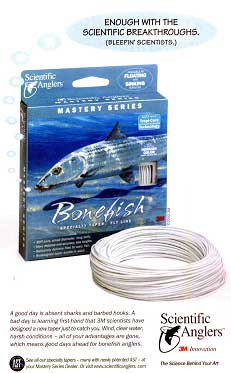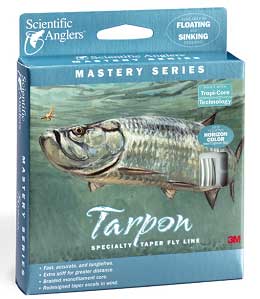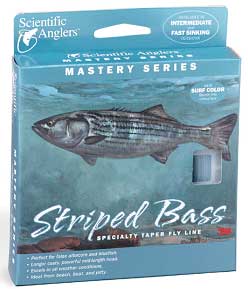Fly Fishing with Doug Macnair: A Product Update - The Great Lines “Tweaked”
Fly Fishing with Doug Macnair: A Product Update - The Great Lines “Tweaked”
By Doug Macnair
 Buying a bad fly line is becoming increasingly difficult with each passing day. Competition is stiff. Whether you choose a line from Airflo, Cortland, Orvis, Rio, Scientific Anglers, Wulff, or even a “house brand” from Cabela’s or L.L. Bean, the odds are the line you select will serve you well, given reasonable tender loving care. Technology has simply multiplied faster than a speeding bullet. Buying a bad fly line is becoming increasingly difficult with each passing day. Competition is stiff. Whether you choose a line from Airflo, Cortland, Orvis, Rio, Scientific Anglers, Wulff, or even a “house brand” from Cabela’s or L.L. Bean, the odds are the line you select will serve you well, given reasonable tender loving care. Technology has simply multiplied faster than a speeding bullet. The Bonefish. I must share a secret with you: for most of the last decade, my favorite fly line has been the Mastery Bonefish by Scientific Angler. I’ve fished it in both fresh and saltwater and in all kinds of weather and never been disappointed in its performance. Unless I’m doing a review or evaluation, it’s the line I always reach for when I’ve just “gone fishin” with a 7-weight or above. It is also true that the Bonefish has been changed for the better with each advance in fly line technology, the most recent being the advent of AST, otherwise known as “Advanced Shooting Technology.”  In truth, I thought this is it! I figured there was little Scientific Anglers could do to make the great AST Bonefish better. I am wrong again! It seems that Bruce Richards of Scientific Anglers has been able to “tweak” several of the Mastery lines making them even better than they were. Fortunately, the Bonefish is on the list. Is it better? You bet! In truth, I thought this is it! I figured there was little Scientific Anglers could do to make the great AST Bonefish better. I am wrong again! It seems that Bruce Richards of Scientific Anglers has been able to “tweak” several of the Mastery lines making them even better than they were. Fortunately, the Bonefish is on the list. Is it better? You bet! The “tweaked” Bonefish retains the AST technology, with the latest changes made to the head and taper. Interesting isn’t it? Fixing something that really doesn’t need fixing is essentially the pursuit of perfection. And while we mortals never achieve it, there seems to always be something that can be done a little better, given the continuing development of technology or a new thought … Apparently, Bruce Richards had a new thought. (Bruce, by the way, is one outstanding fly fisher, not another MBA who makes changes for the sake of change, and/or money.) The new Bonefish features a new compound taper, a stiffer monofilament core and a broad availability in both floating and slow sink versions in WF-5 through WF-9. The heads are approximately 40-43 ft. with long front and rear tapers. And, in case you wondered, the Bonefish is 100 ft. in length. In my trials, the new Bonefish beat out his older brother -- slightly. The noticeable differences were in distance, turnover, and accuracy. None of the improvements resulted in “miracle” change. How then do you say something is better by degrees? I finally decided the best way was to put it in the terms of any golfer could understand: the “tweaked” Bonefish has a larger sweet spot.  The Tarpon. So what do you use if your needs exceed a 9-weight line. The answer is the Tarpon, the first cousin to the Bonefish. The two lines share a lot in common: the same AST coating, the same monofilament core, and a compound taper, although a bit different in configuration from the Bonefish. The Tarpon. So what do you use if your needs exceed a 9-weight line. The answer is the Tarpon, the first cousin to the Bonefish. The two lines share a lot in common: the same AST coating, the same monofilament core, and a compound taper, although a bit different in configuration from the Bonefish. Have you ever had trouble turning over a heavy fly? I think all of us who sometimes chase big fish with bug flies have experienced the frustration and difficulty in casting that big fly -- in fact, if my old brain recalls correctly, it was (and for many remains) a technique called, “Chuck & Duck.” Now I am not going to suggest that Bruce Richards has solved all the problems in throwing a big fly, he hasn’t. He has, however, simplified the turnover of that monster, once launched. That, my friends, is a great change for the better that all of us can appreciate! The idea, of course, is to be able to throw a tarpon class fly a long way with accuracy. That’s exactly the way it is … you will be able to throw a tarpon class fly a long way and, depending on your stroke, accurately. The Tarpon is 110 ft. in length and available in weights 10-14 in both floating and slow sink versions.  The Striped Bass. (I prefer to call it the Striper.) When first announced, this 120-ft. slow sinking intermediate was designed for just what the name implies, casting to stripers off the Atlantic shores. It was then, and remains today, a great line regardless of whether it is the latest “tweak” or the former Striper. The Striped Bass. (I prefer to call it the Striper.) When first announced, this 120-ft. slow sinking intermediate was designed for just what the name implies, casting to stripers off the Atlantic shores. It was then, and remains today, a great line regardless of whether it is the latest “tweak” or the former Striper. Allow me to explain … Initially, SA designed the Striper in two formats, one for the colder waters of the Northeast and the other for the warm waters of Florida, the Gulf, and the waters of the Caribbean. I cannot speak for Florida or the Caribbean, but for the waters of the Gulf, few folks picked up on the Striper. If you took a “north” line south, it could become cooked noodles; on the other hand, a “south” line taken north could become a tangled mess. That’s sad … because in the slow sink format, the Striper is a perfect line when cast from a jetty or even in the flats. Being slightly thinner in diameter than a floater, it is a wind fighter and, because of its slow sink, gets below the weed and wave action. The “tweaked” Striper now offers AST technology, something we have previously discussed in other articles. And, importantly, it offers the advantages of both of the former lines rolled into one. With a head of 38-feet, the revised Striper offers quick casts with the ability to turn over large flies. In my trials, the “tweaked” WF-9 Striper went against my earlier “tropic” version of the same WF-9 line in head-to-head competition. Because of a health problem, I extended the trials over an extended period of time. In the end, I declared a virtual tie between the two lines. Both are wind fighters, both are smooth casting, both have superb range, and both roll cast exceptionally well. Given my frailties as a fly-caster, on one day one line would edge out the other only to find a reversal the next day out. Allow me to offer you three thoughts: (1) Since either line quickly sinks beneath the surface of the water, it can be difficult to tell when you have retrieved sufficient line to make the roll cast. Regardless of which line you end up with either one mandates that you perform a roll cast to re-surface the line before the standard backcast can be made. I suggest nail knotting a marker to the line (perhaps a vivid orange thread) at the point that is within your roll casting range. (2) The second problem that can arise is the fact that your roll casting abilities exceed the range where the line begins to sink before the cast is finished. Said another way; the line closest to the rod tip begins to sink below the surface before the forward portion has finished unrolling. That’s my problem. If I max out my roll cast to say 50 feet, the line closest to the rod tip will be sufficiently below the surface to make the backcast impossible by the time the fly turns over. (Dragging the line from the depths and possibly breaking a fly rod is not something I am into.) (3) Because of their color characteristics, either line seems to disappear in the water (the “tweaked” Striper has the edge). If you think about it for a moment or two, it’s hard to conceive of a need for a leader in excess of four feet, five at the max. More than this will inhibit the roll cast and recovery lifting into the standard backcast. It’s hard to conceive of a line better for the Salt than the Striper. It excels for the purpose intended. On the flats or near surf, it remains my favorite given the vagaries of the Gulf of Mexico. Try the Striper, or more properly the Striped Bass; I think you will like it. Just keep on mind the three watchwords above. The Striper is available in weights 7 through 12. PS. Don’t forget my comments regarding another “tweaked” line, the Mastery XXD, included in the article dealing with Cabela’s Stowaway 7, 4-wgt. Bruce Richards has done a fantastic job of making great line even better. Well folks, that’s it for this the product update. For more information, contact: 3M Scientific Anglers, 3M Center, Bldg. 223-4NE-05, St. Paul, MN 55144-1000. Telephone: 1-(800) 525 -6290.
|
